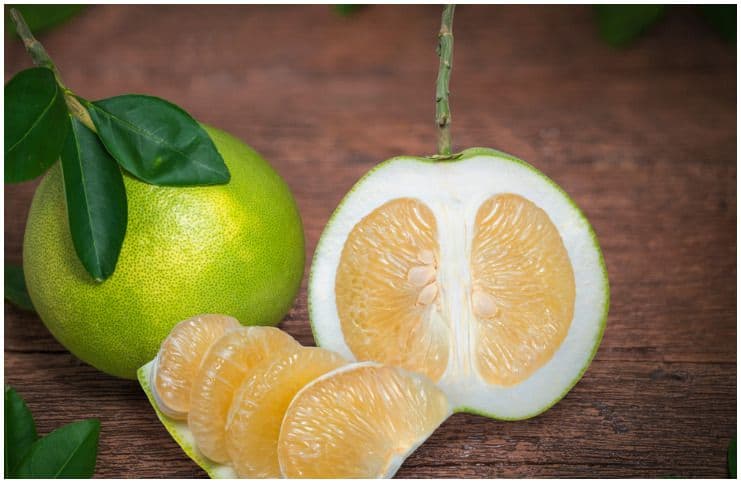Pomelo
Pomelo (scientific name – Citrus grandis), also known as Pamplemousse, or shaddock, is a citrus fruit native to Southeast and South Asia (that’s why many people still use the term Chinese grapefruit).
It has a color that ranges from yellow to mild green with many oil glands.
It has a sweet taste, similar to orange, tangy like tangerine, tart like grapefruit, and very juicy. The white variety is considerably milder in taste than the pink fruit.
It can weigh up to 25 pounds and grow as large as 30cm in diameter. The United States is now one of the biggest producers of these citrus fruits, beating Mexico, China, and other countries.
Nutrition Facts
It contains vitamin C, thiamine, riboflavin, vitamin B6, niacin, protein, dietary fiber, potassium, iron, magnesium, manganese, zinc, and copper.
Health Benefits
Skin Health
Vitamin C, also referred to as L-ascorbic acid, is a potent antioxidant present in many vegetables and fruits. Humans can’t synthesize vitamin C endogenously (unlike most animals), therefore, vitamin C is an essential dietary component. The human body uses vitamin C to make tendons, skin, blood vessels, and ligaments, according to the NIH.
As it is a strong antioxidant, vitamin C helps to keep skin dryness and wrinkles at bay by fighting free radical damage. Also, higher vitamin C intake in daily nutrition has been strongly associated with better cognitive function in seniors.
A condition called scurvy can develop when there is a severe vitamin C deficiency. Scurvy presents itself in otherwise undiagnosable signs and symptoms of bruising, bleeding gums, fatigue, and swelling.
This fruit contains 61 mg of vitamin C that represents about 102% of the daily recommended intake.
Improves Vision
This fruit contains a high amount of beta-carotene, a type of carotenoid which is known as a provitamin A carotenoid since it needs to be converted to active vitamin A by the human body.
Humans need vitamin A for healthy mucous membranes and skin, immune system, and good vision and eye health.
Beta-carotene also works with vitamin E to lower the oxidation of LDL (bad) cholesterol, hence, reducing the risk of coronary heart disease and hardening of the arteries (atherosclerosis).
Cardiovascular Health
Potassium is an essential mineral that is needed for maintaining fluid in the human body and electrolyte balance. Recent research concluded that a higher intake of foods high in vitamin C is strongly associated with a lower risk of cardiovascular disease and stroke.
Moreover, potassium is required to transport ions between cells, which is an important factor in metabolism and helping the heart to work the way it should.
Pamplemousse contains 216 mg of potassium which represents about 6% of the daily recommended intake.
Side Effects
There are no known side effects.
Grapefruit
It is an accidental hybrid from the 18th century between the Pamplemousse and orange, however, nobody knows precisely when it was first grown.
Its taste range from sweet to sour — most usually a refreshing mix of the two. It can be yellow, white, red, or pink with an easily peelable skin, however, it is the color of the flesh inside which determines whether it is a yellow, white, red, or pink fruit.
In the present day, it is being widely cultivated in the US (especially in California and Florida) and China.
Nutrition Facts
It is low in calories but is an excellent source of vitamin C, potassium, copper, manganese, dietary fiber, vitamin B6, niacin, vitamin A, folate, calcium, and magnesium. Furthermore, the red and pink varieties contain carotenoids that include beta-carotene and lycopene.
Health Benefits
Weight Loss
People who consume this fruit prior to each meal shed an average of 3.6 pounds over 3 months, according to a study done at the Nutrition and Metabolic Research Center at Scripps Clinic, California.
Cancer Prevention
This fruit is an excellent source of lycopene which is known for its potential ability to prevent the development of some types of cancer, particularly prostate cancer.
Moreover, lycopene may help decrease the adverse effects of standard cancer treatments as well as slow the growth of tumors.
According to a 2011 study issued in the “Journal of Biological Chemistry,” this fruit has limonoids that activate genes that promote cancer cell death.
In another recent study, the bioflavonoids found in this citrus fruit was discovered to stop cancer cells from spreading in breast cancer sufferers, by ridding the human body of excess estrogen.
Tip
The pith is very rich in nutrients, antioxidants, and soluble fiber that may help you to feel fuller and lower the blood sugar levels.
Side Effects
This fruit has no side effects, except that naringin, a chemical found in grapefruit can negatively interact with some prescription medications, such as those for anxiety, lowering LDL and total cholesterol, and meds to control arrhythmia.
Pomelo vs Grapefruit – Which Has A Better Nutritional Profile?
These two fruits have a similar nutritional profile, but the balance is a little inclined in the favor of pomelo.
Images credit – Shutterstock
READ THIS NEXT: Kiwi Fruit Benefits
